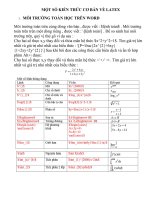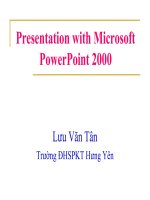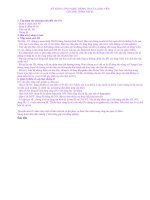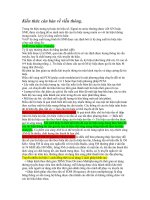Kiến thức căn bản về computer
Bạn đang xem bản rút gọn của tài liệu. Xem và tải ngay bản đầy đủ của tài liệu tại đây (223.73 KB, 9 trang )
Unit 3: Personal computer
I. What is a personal computer?
A personal computer (PC) is a computer whose original sales price, size, and capabilities make it useful for
individuals.
It is unknown who coined the phrase with the intent of a small affordable computing device but John W.
Mauchly described such a device in a November 3, 1962 New York Times article entitled "Pocket Computer may
replace Shopping List". Six years later a manufacturer took a risk at referring to their product this way when
Hewlett Packard advertised their "Powerful Computing Genie" as "The New Hewlett Packard 9100A personal
computer". This advertisement was too extreme for the target audience and replaced with a much drier ad for the
HP 9100A programmable calculator. During the next 7 years the phrase had gained usage so when Byte
magazine, published its first edition it referred to its readers as being in the "personal computing field" while
Creative Computing defined the personal computer as a "non-(time)shared system containing sufficient
processing power and storage capabilities to satisfy the needs of an individual user." Two years later when the
1977 Trinity of preassembled small computers hit the markets, the Apple II and the PET 2001 were advertised as
'personal computers' while the TRS-80 was a microcomputer used for household tasks including "personal
financial management". By 1979 over half a million microcomputers were sold and the youth of the day had a
new concept of the personal computer. The Personal Computer was also the first non-human abstract to be the
Time Magazine Person of the Year.
Personal computers can be categorized by size and portability:
• Desktop computers
• Laptop or notebooks
• Personal digital assistants (PDAs)
• Portable computers
• Tablet computers
• Wearable computers
• Cell Phones
In their early years personal computer was interchangeable with Microcomputers and home computers. Often,
the term "personal computer" is used exclusively for computers running a Microsoft Windows operating system,
but this is erroneous. For example, a Macintosh running Mac OS and an IBM PC compatible running
GNU/Linux are both personal computers. This confusion stems from the fact that the term "PC" is often used as
a shorthand form for "IBM PC compatible" and historically Mac OS has run on non-IBM compatible hardware
like the PowerPC architecture. Newer personal computing devices have had their OS wars with WindowsCE
struggling with PalmOS in the PDA markets and now the cell phone devices have gotten powerful enough to
start a whole new struggle to define the personal computer, its operating system and how we use it in our daily
lives.
II. History
1. Mainframes and large minicomputers
Time shared computer terminals connected to central computers, such as the TeleVideo ASCII character mode
smart terminal pictured here, were sometimes used before the advent of the PC.
Before the introduction of the microprocessor in the early 1970s, computers were generally large, costly systems
owned by large corporations, universities, government agencies, and similar-sized institutions. End users often
did not directly interact with the machine but instead would prepare tasks for the computer on off-line
equipment, such as card punches. A number of assignments for the computer would be gathered up and
processed in batch mode. After the job had completed, users could collect the results. In some cases it could take
hours or days between submitting a job to the computing center and receiving the output.
A more interactive form of computer use developed commercially by the middle 1960s. In a time-sharing
system, multiple computer terminals let many people share the use of one mainframe computer processor. This
was common in business applications and in science and engineering.
A different model of computer use was foreshadowed by the way in which early, pre-commercial, experimental
computers were used, where one user had exclusive use of a processor. Some of the first computers that might be
called "personal" were early minicomputers such as the LINC and PDP-8, and later on VAX and larger
minicomputers from Digital Equipment Corporation (DEC), Data General, Prime Computer, and others. By
today's standards they were very large (about the size of a refrigerator) and cost prohibitive (typically tens of
thousands of US dollars), and thus were rarely purchased by an individual. However, they were much smaller,
less expensive, and generally simpler to operate than many of the mainframe computers of the time. Therefore,
they were accessible for individual laboratories and research projects. Minicomputers largely freed these
organizations from the batch processing and bureaucracy of a commercial or university computing center.
In addition, minicomputers were relatively interactive and soon had their own operating systems. The
minicomputer Xerox Alto (1973) was a landmark step in the development of personal computers, because of its
graphical user interface, bit-mapped high resolution screen, large internal and external memory storage, mouse,
and special software.
[10]
The minicomputer era was an intermediary step from mainframes to personal computer
usage.
2. Computers at home
The 1977 Apple II, one of the 1977 Trinity. Floppy drive pictured a model designed for the Apple III.
One early use of the term "personal computer" appeared in a November 3, 1962, New York Times article
reporting John W. Mauchly's vision of future computing as detailed at a recent meeting of the American Institute
of Industrial Engineers. Mauchly stated, "There is no reason to suppose the average boy or girl cannot be master
of a personal computer. "
The minicomputer ancestors of the modern personal computer used early integrated circuit (microchip)
technology, which reduced size and cost, but they contained no microprocessor. This meant that they were still
large and difficult to manufacture just like their mainframe predecessors. After the "computer-on-a-chip" was
commercialized, the cost to manufacture a computer system dropped dramatically. The arithmetic, logic, and
control functions that previously occupied several costly circuit boards were now available in one integrated
circuit, making it possible to produce them in high volume. Concurrently, advances in the development of solid
state memory eliminated the bulky, costly, and power-hungry magnetic core memory used in prior generations
of computers.
There were a few researchers at places such as SRI and Xerox PARC who were working on computers that a
single person could use and could be connected by fast, versatile networks: not home computers, but personal
ones.
A programmable terminal called the Datapoint 2200 is the earliest known device that bears any significant
resemblance to the modern personal computer. It was made by CTC (now known as Datapoint) in 1970 and was
a complete system in a small case bearing the approximate footprint of an IBM Selectric typewriter. The
system's CPU was constructed from a variety of discrete components, although the company had commissioned
Intel to develop a single-chip processing unit; there was a falling out between CTC and Intel, and the chip Intel
had developed wasn't used. Intel soon released a modified version of that chip as the Intel 8008, the world's first
8-bit microprocessor. The needs and requirements of the Datapoint 2200 therefore determined the nature of the
8008, upon which all successive processors used in IBM-compatible PCs were based. Additionally, the design of
the Datapoint 2200's multi-chip CPU and the final design of the Intel 8008 were so similar that the two are
largely software-compatible; therefore, the Datapoint 2200, from a practical perspective, can be regarded as if it
were indeed powered by an 8008, which makes it a strong candidate for the title of "first microcomputer" as
well.
Development of the single-chip microprocessor was an enormous catalyst to the popularization of cheap, easy to
use, and truly personal computers. The Altair 8800, introduced in a Popular Electronics magazine article in the
January 1975 issue, at the time set a new low price point for a computer, bringing computer ownership to an
admittedly select market in the 1970s. This was followed by the IMSAI 8080 computer, with similar abilities
and limitations. The Altair and IMSAI were essentially scaled-down minicomputers and were incomplete: to
connect a keyboard or screen to them required heavy, expensive "peripherals". These machines both featured a
front panel with switches and lights, which communicated with the operator in binary. To program the machine,
one didn't simply power up: one first had to key in the bootstrap loader program in binary, then read in a paper
tape containing a BASIC interpreter, using a massive paper-tape reader. Keying the loader required setting a
bank of eight switches up or down and pressing the "load" button, once for each byte of the program, which was
typically hundreds of bytes long. This was before one could begin to do any computing. (At the first West Coast
Computer Faire, a three-year-old girl amused herself by flipping random switches and pressing the Load button,
which were at her eye level, then moving on to the next demo. By doing so, she had inserted a random number
into the location whose address was in the Program Counter, thus crashing the machine. She was followed by
gasps and screams as the vendors discovered that they had to repeat the whole start-up cycle—her parents found
her by heading for the commotion. The next Computer Faire banned small children. A Few years later, personal
computers lost the switches and lights; thirty years later, they have memory protection, so that crashing a single
program doesn't crash the machine.)
[citation needed]
In 1976, the Kooro Manufacturing & Electronics Cooperative in Skopje, Macedonia produced in limited
quantities, an all in one (integrated keyboard, monochrome monitor, 8 inch floppy disk drive and 16k of ram) for
use by government officials. Similar in appearance to the TRS-80 Model III computer using a proprietary
operating system.
It was arguably the Altair computer that spawned the development of Apple, as well as Microsoft which
produced and sold the Altair BASIC programming language interpreter, Microsoft's first product. The second
generation of microcomputers — those that appeared in the late 1970s, sparked by the unexpected demand for
the kit computers at the electronic hobbyist clubs, were usually known as home computers. For business use
these systems were less capable and in some ways less versatile than the large business computers of the day.
They were designed for fun and educational purposes, not so much for practical use. And although you could use
some simple office/productivity applications on them, they were generally used by computer enthusiasts for
learning to program and for running computer games, for which the personal computers of the period were less
suitable and much too expensive. For the more technical hobbyists home computers were also used for
electronics interfacing, such as controlling model railroads, and other general hobbyist pursuits.
The MOS Technology 6502 series microprocessor lead to a reduction in the expense of creating computing
systems. The Commodore PET, the TRS 80, and the Apple II, also known as the 1977 Trinity by Byte magazine,
are often cited as the first personal computers. Specifically, the Commodore PET, which Byte called the first.
The design of the Commodore PET, a single integrated machine with a built in monitor, keyboard, and datasette
device, and the operating system of the Xerox Alto went on to inspire the popular Macintosh computer, by
Apple.
A 1978 ad for the Apple II used the wording "Apple, the personal computer". There was no trademark symbol.
Three years later, the term "personal computer" was a trademark of IBM, which had decided to invade the
microcomputer market and had done it successfully; a few years later, a judge declared that "personal computer"
was no longer an IBM trademark, but a generic term for any personal computer not made by Apple.
3. Back to business
A release photo of the original IBM PC (ca. 1981).
It was the launch of the VisiCalc spreadsheet, initially for the Apple II (and later for the Atari 8-bit family,
Commodore PET, and IBM PC) that turned the microcomputer into a business tool. In fact, An Apple employee
discovered in 1980 that IBM's San Jose research lab had purchased several Apple IIs, solely to run VisiCalc.
This was followed by the August 12, 1981 release of the IBM PC, which would revolutionize the computer
market. The Lotus 1-2-3, a combined spreadsheet (inspired by VisiCalc), presentation graphics, and simple
database application, would become the PC's own killer application. Good word processor programs didn't
appear for personal computers till 1985. The earlier versions were dominated by WordStar but were not
comparable to standalone word processors or those found on mini-computers. WordPerfect 4.1 for the IBM 5150
and Microsoft Word 1.0 for the Apple Macintosh both released in 1985 were enough reason to justify the entire
cost of purchasing the computers for individual office workers giving these programs the status of killer
applications.
In the January 3, 1983 issue of Time magazine, the personal computer was named the "Person of the Year" for
1982.
4. Uses
Personal computers are normally operated by one user at a time to perform such general purpose tasks as word
processing, Internet browsing, Internet faxing, e-mail and other digital messaging, multimedia playback,
computer game play, computer programming, etc. The user of a modern personal computer may have significant
knowledge of the operating environment and application programs, but is not necessarily interested in
programming nor even able to write programs for the computer. Therefore, most software written primarily for
personal computers tends to be designed with simplicity of use, or "user-friendliness" in mind. However, the
software industry continuously provide a wide range of new products for use in personal computers, targeted at
both the expert and the non-expert user.
5. Configuration
An exploded view of a modern personal computer:
1. Monitor
2. Motherboard
3. CPU (Microprocessor)
4. Primary storage (RAM)
5. Expansion cards









